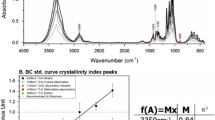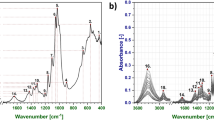Abstract
The concentrations of water, W, and electrolytes present in solutions of LiCl in N,N-dimethylacetamide, LiCl/DMAc, and of tetrabutylammonium fluoride. x-hydrate in DMSO, TBAF.xW/DMSO can be accurately and expediently determined by three independent methods, UV–vis, FTIR and EMF measurement. The first relies on the use of solvatochromic probes whose spectra are sensitive to solution composition. It is applicable to W/LiCl/DMAc solutions but not to TBAF.xW/DMSO, because the charge-transfer complex bands of the probes are suppressed by strong interactions with the latter electrolyte. Integration of νOH band of water may be employed in order to determine [W], hence [electrolyte] by weight difference. EMF measurement uses ion-selective electrodes in order to determine [electrolyte], hence [W] by weight difference. Results of the latter method were in excellent agreement with those of FTIR. The reason for the failure of Karl Fischer titration is addressed, and the relevance of the results obtained to functionalization of cellulose under homogenous solution conditions is briefly commented on.
Similar content being viewed by others
References
Abakshin V.A., Krestov G.A., Eliseeva O.V. (1987). Relationship between the relative solubility of highly associated 1–1 electrolytes and the dielectric permeability of the solvent. Zh. Obshchei Khim. 57: 1606–1609
Abe Y., Mochizuki A. (2003). Hemodialysis membrane prepared from cellulose/N-methylmorpholine-N-oxide solution. III: the relationship between the drying condition of the membrane and its permeation behavior. J. Appl. Polym. Sci. 89: 1671–1681
Aichert A., De Caro C.A., Huber R. and Walter C.M. 1998. Sample preparation: a key issue in Karl Fischer titration. In: Proceedings of the 3rd International Symposium on Humidity and Moisture, Teddington UK, 141p.
Armarego W.F.L., Chai C.L.L. (2003). Purification of Laboratory Chemicals. Elsevier, London, fifth edition
Ass B.A., Frollini E., Heinze T. (2004). Studies on the homogeneous acetylation of cellulose in the novel solvent dimethylsulfoxide/tetrabutylammonium fluoride trihydrate. Macromol. Biosci. 4: 1008–1013
De Caro C.A., Aichert A., Walter C.A. (2001). Efficient, precise and fast water determination by the Karl Fischer titration. Food Contr. 12: 431–436
Casey M., Leonard J., Lygo B., Procter G. (1990). Advanced Practical Organic Chemistry. Chapman & Hall, New York, pp. 43–73
Chavan R.B., Patra A.K. (2004). Development and processing of lyocell. Ind. J. Fibre Textile Res. 29: 483–492
Coleman P.B. (1993). Practical Sampling Techniques for Infrared Analysis. CRC, Boca Raton, pp. 11
Dawsey T.R., McCormick C.L. (1990). The lithium chloride/dimethylacetamide solvent for cellulose: a literature review. J. Macromol. Sci. – Rev. Macromol. Chem. Phys. C30:405–440
Diamantoglou M., Brandner A. and Meyer G. 1984. Water-insoluble fibers from cellulose acetate, cellulose propionate and cellulose butyrate with an extremely high absorption capacity for water and physiological fluids. Ger. offen. (1984), DE 3246417 Al 19840620
Diamantoglou M., Vienken J. (1996). Strategies for the development of hemocompatible dialysis membranes. Macrom. Symp. 103: 31–42
Dunkel R., Hahn M., Borisch K., Neumann B., Ruttinger H.-H., Tschierske C. (1998). Determination of the water content of amphiphilic liquid crystals by coulometric Karl Fischer titration. Liq. Cryst. 24: 211–213
Dupont A. (2003). Cellulose in lithium chloride/N,N-dimethylacetamide, optimization of a dissolution method using paper substrates and stability of the solutions. Polymer 44: 4117–4126
El Seoud O.A., Marson G.A., Ciacco G.T., Frollini E. (2000). An efficient, one-pot acylation of cellulose under homogeneous reaction conditions. Macromol. Chem. Phys. 201: 882–889
El Seoud O.A. and Heinze T. 2005. Organic esters of cellulose: new perspectives for old polymers. Advan. Polym. Sci. Springer-Verlag, Berlin, p. 103–149
Heinze T., Dicke R., Kull A.H., Klohr E.-A. and Koch W. 1999. Effective preparation of cellulose derivatives in a new simple cellulose solvent. Macromol. Chem. Phys. 201: 627–631
Heinze T., Dicke R., Koschella A., Kull A.H., Klohr E.-A., Koch W. (2000). Effective preparation of cellulose derivatives in a new simple cellulose solvent. Macromol. Chem. Phys. 201: 627–631
Heinze T., Liebert T. (2001). Unconventional methods in cellulose functionalization. Prog. Polym. Sci. 26: 1689–1762
Heinze T., Liebert T., Pfeiffer K., Hussain M.A. (2003). Unconventional cellulose esters: synthesis, characterization and structure-property relations. Cellulose 10: 283–296
Heinze T., Liebert T. (2004). Chemical characteristics of cellulose acetate. Macrom. Symp. 208: 167–237
Heinze T., Schwikal K., Barthel S. (2005). Ionic liquids as reaction medium for cellulose functionalization. Macromol. Biosci. 5: 520–525
Ikeda I., Washino K., Maeda Y. (2003). Graft polymerization of cyclic compounds on cellulose dissolved in tetrabutylammonium fluoride/dimethylsulfoxide. Sen’i Gakkaishi 59: 110–114
James D., David W., Frost R.L. (1978). Structure of aqueous solutions. Infrared librational band study of structure making and structure breaking by dissolved electrolytes. J. Chem. Soc., Faraday Trans. 174: 583–596
Kessler M.A., Wolfbeis O.S. (1989). E T(33), a solvatochromic polarity and micellar probe for neutral aqueous solutions. Chem. Phys. Lipids 50: 51–56
Lacey R.E. (1997). Dialysis and Electrodialysis. Handbook of Separation Techniques for Chemical Engineers. Wiley, New York, p. 619–635 (3rd Edition)
Kolthoff J.M. and Elving P.J. (1971). Treatise on Analytical Chemistry, Vol. 1, Part II, Sect. A. Interscience, New York, p. 69
Langhals H. (1982). Polarity of binary liquid mixtures. Angew. Chem. Int. Ed. Engl. 21: 724–733
Levkin A.V. and Tsivadze A.Y. (1986). Solubility of lithium and potassium halides in pyridine, acetonitrile, and\(\gamma\)-butyrolactone. Zh. Neorganicheskoi Khim. 31: 284–5
Lindgren J. and Kersti H. (1993). Theoretical simulation and experimental determination of OH and OD stretching bands of isotopically diluted HDO molecules in aqueous electrolyte solutions. J. Phys. Chem. 97: 5254–5259
Liptak B.G. (1994). Analytical Instrumentation. Chilton Book Company, Pennsylvania, p. 186
Marcus Y. (1997). Ion Properties. Marcel Dekker, New York, pp. 209
Max J.-J. and Chapados C. (2001). IR spectroscopy of aqueous alkali halide solutions: Pure salt-solvated water spectra and hydration numbers. J. Chem. Phys. 115: 2664–2675
Motojima T., Ikawa S. and Kimura M. (1981). Infrared intensities of ion–water interactions in aqueous electrolyte solutions. J. Quant. Spectrosc. Radiative Transfer 26: 177–185
Mundy W.C., Gutierrez L. and Spedding F.H. (1973). Raman intensities of the uncoupled hydroxyl-doscillators in liquid water. J. Chem. Phys. 59: 2173–2182
Mussini T., Covington A.K., Longhi P. and Rondinini S. (1985). Criteria for standardization of pH measurements in organic solvents and water+organic solvent mixtures of moderate to high permitivities. Pure Appl. Chem. 57: 865–876
Nakayama H. (1983). Hydrates of organic compounds. VII. The effect of anions on the formation of clathrate hydrates of tetrabutylammonium salts. Bull. Chem. Soc. Jpn. 56: 877–880
Pearson R.G. (1988). Absolute electronegativity and hardness: applications to organic chemistry. J. Org. Chem. 54: 1423–1430
Potthast A., Rosenau T., Buchner R., Röder T., Ebner G., Bruglachner H., Sixta H. and Kosma P. (2002). The cellulose solvent system N,N-dimethylacetamide/lithium chloride revisited: the effect of water on physicochemical properties and chemical stability. Cellulose 9: 41–53
Ramos L.A., Assaf J.M., El Seoud O.A. and Frollini E. (2005). Influence of the supramolecular structure and physicochemical properties of cellulose on its dissolution in lithium chloride/N,N-dimetylacetamide solvent system. Biomacromology 6: 2638–2647
Reichardt C. (2003). Solvents and Solvent Effects in Organic Chemistry. Verlag Chemie, Weinheim, p. 389, 3rd Edition
Röder T., Morgenstern B., Schelosky N. and Glatter O. (2001). Solutions of cellulose in N,N-dimethylacetamide/lithium chloride studied by light scattering methods. Polymer 42: 6765–6773
Samaranayake G. and Glasser W. (1993). Cellulose derivatives with low DS. I: a novel acylation system. Carbohyd. Polym. 22: 1–7
Scherer J.R. 1980. The vibrational spectroscopy of water. In: Clark R.J. and Hester R.E. (eds), Advanced Infrared Raman Spectroscopy. Wiley, New York, pp. 149–216
Scholz E. (1984). Karl-Fischer Tritation. Springer-Verlag, Berlin
Sharma R.K. and Fry J.L. (1983). Instability of anhydrous tetra-n-alkylammonium fluoride. J. Org. Chem. 48: 2112–2114
Sipos P., Bódi I., May P.M. and Hefter G.T. (1997). The ionic product of water in concentrated tetramethylammonium chloride solutions. Talanta 44: 617–620
Sjoholm E., Gustafsson K., Pettersson B. and Colmsjo A. (1997). Characterization of the cellulosic residues from lithium chloride/N,N-dimethylacetamide dissolution of softwood kraft pulp. Carbohydr. Polym. 32: 57–63
Spear S.K., Holbrey J.D. and Rogers R.D. (2004). Production of bioactive cellulose films reconstituted from ionic liquids. Biomacromology 5: 1379–1384
Steinmeier H. (2004). Chemistry of cellulose acetylation. Macrom. Symp. 208: 49–60
Sun H. and DiMagno S.G. (2005). Anhydrous tetrabutylammonium fluoride. J. Am. Chem. Soc. 127: 2050–2051
Swatloski R.P., Spear S.K., Holbrey J.D. and Rogers R.B. (2002). Dissolution of cellulose with ionic liquids. J. Am. Chem. Soc. 124: 4974–4975
Tada E.B., Novaki L.P. and El Seoud O.A. (2000). Solvatochromism in pure and binary solvent mixtures: effects of the molecular structure of the zwitterionic probe. J. Phys. Org. Chem. 13: 679–687
Tada E.B., Silva P.L. and El Seoud O.A. (2003). Thermo-solvatochromism of betaine dyes in aqueous alcohols: explicit consideration of the water–alcohol complex. J. Phys. Org. Chem. 16: 691–699
Tada E.B. 2004. Use of Solvatochromic Dyes to Study Solvation in Pure Solvents, Their Mixtures, and Micellar Solutions. Ph.D Thesis, University of São Paulo
Tada E.B., Silva P.L., Tavares C. and El Seoud O.A. (2005). Thermo-solvatochromism of zwitterionic probes in aqueous aliphatic alcohols and in aqueous 2-alkoxyethanols: relevance to the enthalpies of activation of chemical reactions. J. Phys. Org. Chem. 18: 398–407
Terbojevich M., Cosani A., Camilot M. and Focher B. (1995). Solution studies of cellulose tricarbanilates obtained in homogeneous phase. J. Appl. Polym. Sci. 55: 1663–1671
Tiddy G.J.T. (1980). Surfactant-water liquid crystal phases. Phys. Rep. 57: 1–46
Toyoshima I. (1993). Highly advanced utilization and functionalization of cellulose from the aspects of both chemistry and industry. In: Kennedy John F., Phillips Glyn O., Williams Peter A. (eds). Cellulosics: Chemical, Biochemical and Material Aspects. Ellis Horwoods, New York, p. 125–134
Turner M.B., Spear S.K., Holbrey J.D. and Rogers R.D. 2004. Production of bioactive cellulose films reconstituted from ionic liquids. Biomacromol. 5: 1379–1384
Wiafe-Akenten J. and Bansil R. (1983). Intermolecular coupling in water-D1 solutions. J. Chem. Phys. 78: 7132–7137
Woodings C.R. (1995). The development of advanced cellulosic fibers. Intern. J. Biol. Macrom. 17: 305–309
Wu J., Zhang J., Zhang H., He J., Ren Q. and Guo M. (2004). Homogeneous acetylation of cellulose in a new nonic liquid. Biomacromology 5: 266–268
Wynn D.A., Roth M.M. and Pollard B.D. (1984). The solubility of alkali-metal flourides in non-aqueous solvents with and without crown ethers, as determined by flame emission spectrometry. Talanta 31:1036–1040
Acknowledgements
The authors thank the Research Foundation of São Paulo (FAPESP) for financial support and␣a␣pre-doctoral fellowship to L.C. Fidale, the Brazilian National Research Council (CNPq) for a␣research fellowship to O.A. El Seoud, the Deutsche Akademischer Austausch Dienst (DAAD) for a fellowship to M.H.G. Prechtl during his stay in São Paulo, the Werkstoffe aus Nachwachsenden Rohstoffen agency (WNR) for financial support to S. Köhler during her stay in São Paulo, Vanessa R. Marques of the Quality Control Department, Colgate-Palmolive, São Paulo, for making the fluoride SIE available to us, Dr Paulo A.R. Pires and Mr C. Guizzo for their help.
Author information
Authors and Affiliations
Corresponding author
Rights and permissions
About this article
Cite this article
Fidale, L.C., Köhler, S., Prechtl, M.H. et al. Simple, expedient methods for the determination of water and electrolyte contents of cellulose solvent systems. Cellulose 13, 581–592 (2006). https://doi.org/10.1007/s10570-005-9036-x
Received:
Accepted:
Published:
Issue Date:
DOI: https://doi.org/10.1007/s10570-005-9036-x




